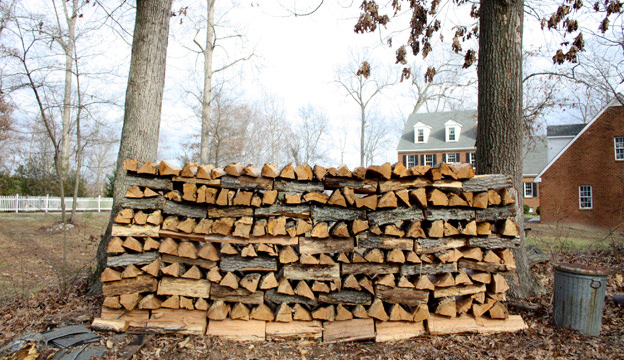
Choosing the best trees for firewood is an important decision to ponder. (For more on saving time and effort splitting wood, see our Beginning Farmer’s Guide to Log Splitters.) Just as some types of wood aren’t suitable for making some products (it’s not a good idea to make a cutting board, for example, from softwoods such as pine or fir), some types of wood aren’t suitable for use as firewood. However, with so many different types of wood, learning which trees make good firewood can be a time-consuming and labor-intensive process. To help you avoid this, here are some tips to help with your firewood selection. (And to help you avoid the risk of chimney fires, read how to manage and minimize creosote buildup in your chimney.)
The Best Firewood
I’ll preface this by saying that wood from many trees can make quality firewood, and highlighting only the very best excludes some very usable trees. Also, what constitutes the “best” firewood varies depending on its planned use. If you use firewood as the primary heat source for your house, you’ll want a high-quality wood that produces a lot of heat. If, on the other hand, your main interest is creating a fire to add ambiance and atmosphere to a winter evening, you might be fine with a lower-quality wood. With that established, here are a handful of trees that stand above all others when it comes to producing quality firewood.
Oak for Firewood
The best-known firewoods are white and red oak trees. The wood from these oak trees is prized for its strength and density, and that density makes it one of the best at producing heat.
Hickory
The wood from the hickory family of trees, which includes pecan trees, is also very dense and prized for use as firewood, being of similar quality to oak.
Black Locust
One lesser-known tree that makes great firewood is black locust. The species has a fairly limited range, growing in just a handful of states through the Appalachian Mountains and into Missouri and Arkansas, but it produces a strong, dense wood famous for making fence posts. Not surprisingly, the same density and durability that makes black locust good for fence posts also makes it among the best firewood trees.
Other Good Wood to Burn
White ash, sugar maple and birch trees also produce excellent firewood, albeit not quite as good as oak and hickory. But all three have their advantages:
- Sugar maple has a good reputation for burning with few sparks and less smoke than what’s produced by other woods.
- White ash weighs less than most other types of quality firewood and is easier to split into burnable logs.
- The bark of many mature birch trees is quite flammable, making it good for easily starting fires.

The Worst Trees for Firewood
Coniferous Trees in General
As a general rule, most coniferous or “softwood” trees—the types of trees that have needles rather than leaves—are not well-suited for use as firewood. As their “softwood” nickname implies, coniferous trees usually have softer, less dense wood than deciduous trees, which have leaves, meaning softwoods provide less fuel for the fire and usually produce less heat. You can certainly burn it, but the wood from coniferous trees also contains pitch and is notorious for creating creosote buildup when it burns. Creosote can stick to the walls of your chimney and become a fire hazard. These woods also tend to produce more sparks and smoke, which can spoil the mood that you want to generate by starting a nice, cozy wood fire.
Hemlocks in Particular
One coniferous tree you probably don’t want to burn at all is hemlock, as it’s roughly akin to burning a rock. The wood of hemlock trees (not to be confused with the poisonous plant of the same name) features extremely hard knots that make the trees difficult to split into burnable logs. Even if you get hemlock wood to the point where it can be burned, it produces sparks sure to discourage you from ever burning that type of wood again.
Deciduous Trees
Some deciduous trees also don’t make good firewood. Aspen, basswood and willow trees all have very soft wood of generally poor quality for burning and producing heat. That said, this wood is a little better than that of most coniferous trees because it doesn’t spark as much.
As you can see, there’s plenty to consider when evaluating the best and worst types of firewood. (Once you’ve found trees you want to use, learn how to cut and store the wood.) Which trees you choose depends at least in part on their availability in your area, but if you secure a winter stockpile of oak, hickory, maple, ash or black locust firewood, you’ll be rewarded with many warm, smoke- and spark-free fires on cold winter evenings.
This article about the best trees for firewood was written for Hobby Farms magazine. Click here to subscribe.




